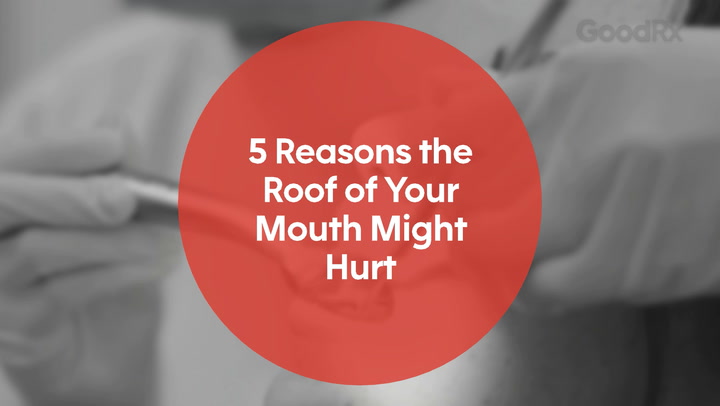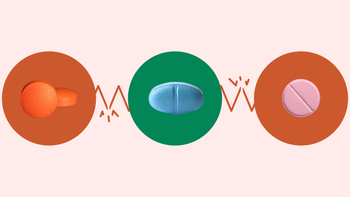
What Is Radiculopathy (Pinched Nerve)? Symptoms, Types, and Treatment
Key takeaways:
Radiculopathy is an irritation of a nerve root in the spine. The symptoms of pain, numbness, tingling, and weakness can be so severe that they affect your daily life.
Lumbar radiculopathy is the most common type, and it can cause back, leg, or foot symptoms. Cervical radiculopathy can cause symptoms in the neck, arm, or hand.
Radiculopathy sometimes gets better on its own. There are several treatment options for radiculopathy, like medications, physical therapy, and injections. Some people may need surgery, depending on their symptoms.
Access savings on related medications
Table of contents

Two of the most common complaints in primary care are neck and back pain. In fact, up to 20% of adults have either neck or back pain at any given time. Sometimes these symptoms are due to radiculopathy. Radiculopathy is more common in the back, but it can also occur in the neck — both of which can affect your daily life.
Many people can’t enjoy their usual activities due to the pain and weakness radiculopathy can cause. Fortunately, for most people, the pain and discomfort are temporary. If you have radiculopathy, understanding the symptoms, causes, and treatments can help you know what to expect.
What is radiculopathy?
Radiculopathy is an irritation or compression of a nerve root in the spine. People often call it a “pinched nerve.” But inflammation can cause irritation to the nerve, even if the nerve isn’t pinched or compressed.
Save every month on GLP-1 meds with GoodRx
Save an average of $235 on FDA-approved GLP-1s like Ozempic and Zepbound.

Types of radiculopathy
There are different types of radiculopathy based on location of the affected nerve root. Nerve roots exit the spinal cord and run near the discs of the spine down to the rest of your body. The nerves then reach the limbs and send signals for movement and sensation to your arms and legs. The type of radiculopathy you have will depend on where the affected nerve is along the spine.
Types of radiculopathy include:
Cervical radiculopathy: Nerve roots in the neck or cervical spine
Thoracic radiculopathy: Nerve roots in the middle of the back or thoracic spine
Lumbar radiculopathy: Nerve roots in the low back or lumbar spine
Lumbosacral radiculopathy: Nerve roots in the lowest part of the spine
What causes radiculopathy?
The causes of radiculopathy can vary based on age and the area of the spine affected. But, in general, the most common causes of radiculopathy are a herniated disc and degenerative disc disease — or changes due to wear and tear. A herniated disc is when the cushion between the bones of your spine slips out of place and pushes on the nerve, which causes pain.

The most common cause of cervical radiculopathy in younger adults is disc herniation. Certain activities can increase your risk for cervical radiculopathy, including:
Heavy lifting
Handling vibrating equipment
Smoking
Having neck trauma
In older adults, radiculopathy is more often due to degenerative changes of the spine. Degenerative changes happen when the cushion of the disc has age-related thinning and damage. With age, arthritis can narrow the canal where the nerve root runs and compress it.
Many cases of cervical radiculopathy improve with physical therapy and exercise. These exercises may help your symptoms improve faster.
Sciatica treatments: Check out this list of prescription medications that can help relieve sciatica pain.
When should you go to the ER for back pain? These signs could mean you need to seek medical attention right away.
The most common causes of thoracic radiculopathy are disc disease and nerve damage due to diabetes. In rare cases, it may also be due to thoracic surgery.
Degenerative changes and disc injuries are common causes for lumbar radiculopathy. But other causes may include fractures, tumors, or infections.
Symptoms of radiculopathy
The symptoms of radiculopathy will also vary depending on the nerve root it affects. It typically involves pain, numbness, or weakness.
Symptoms of cervical radiculopathy include:
Neck pain that goes down the arm, upper back, or shoulder
Numbness and tingling, or an electrical sensation down the arm
Muscle weakness of the arm or hand
Symptoms of lumbar radiculopathy typically involve sciatica. Sciatica refers to pain that starts at the buttock and shoots down the leg. Sciatica pain can happen with radiculopathy or other irritation of the nerve root. It may also come from irritation of the sciatic nerve itself.
Common sciatica symptoms include:
Low-back pain that goes down the leg and foot
Numbness and tingling, or a shooting pain down the leg
Leg or foot weakness (It may cause trouble walking or falls, in severe cases.)
Thoracic radiculopathies aren’t as common. Symptoms include a burning or shooting pain in these areas:
Upper to middle back
Torso
Chest wall
Abdomen
Inner arm
Radiculopathy diagnosis
A healthcare professional may have different ways to check your radiculopathy symptoms. These can include:
Physical exam: This exam will check your muscle strength, reflexes, and sensation.
Imaging studies: This could include X-rays of the spine or a CT scan. For chronic pain, MRI is the preferred imaging to check for herniated discs and nerve compression. You may also have an MRI before certain treatments, like injection or surgery.
Electromyography and nerve conduction studies: These check the function of the nerves and can help find the irritated nerve.
Treatments for radiculopathy
Treatment is conservative for most radiculopathy cases. Most of the time cervical radiculopathy responds well. Similarly, most cases of low back pain with radiculopathy improve spontaneously (on their own).
For cases of radiculopathy that don’t improve, there are many treatments available. Treatments vary based on your symptoms and the severity.
Treatments for radiculopathy often include:
Medications
Injections
Surgery
Spinal cord stimulation
Physical therapy
Medical devices, such as cervical traction devices and cervical collars
Medications
There are several medications that can treat nerve root pain. A healthcare professional may prescribe a combination of two or more medications.
Some medications that can treat radiculopathy are:
Acetaminophen (Tylenol): Tylenol is commonly used because it’s safe and inexpensive. But be careful not to take more than 4 g per day.
Nonsteroidal anti-inflammatories (NSAIDs): NSAIDs are only for short-term use, in order to avoid gastric ulcers or cardiovascular complications.
Oral steroids: Some people improve with a tapered dose of oral steroids. Prednisone is a common one.
Muscle relaxants: These are a popular option for pain relief, although they may make you drowsy.
Antiepileptics: These are medications that prevent seizures. But they also help to treat nerve pain. Gabapentin and pregabalin are among the most common.
Antidepressants: Duloxetine (Cymbalta) can help treat nerve pain.
Opioids: These have a potential for abuse and addiction, so they’re only for severe pain and require careful use.
Injections
Epidural steroid injections help decrease inflammation around the nerve root. These work by injecting the medication into the fluid around the spinal cord. Your healthcare team will use X-rays to make sure you get the injection in the right location. They’ll inject a mixture of a steroid and local anesthesia to relieve pain and inflammation.
Epidural injections are a common type of injection. You may get immediate relief from your symptoms, but it may not provide long-term relief. Some people may benefit from injections in other locations of the spine as well, like injections in the joints of the spine.
Surgery
Surgery may be an option for people whose symptoms don’t improve with less invasive treatment. Those who have severe symptoms or symptoms that started after an injury may need surgery.
Examples of severe symptoms that may need surgery include:
Severe weakness
Loss of bowel or bladder control
Debilitating pain
The specific type of surgery depends on the cause of the radiculopathy and the location. Surgery for cervical radiculopathy may be done from the front or the back of the neck. Surgeons also use several techniques for lumbar radiculopathy. Over the years, less invasive procedures have become more common.
Spinal cord stimulator
A spinal cord stimulator is a device that a provider implants under the skin. It transmits electrical pulses to the spinal cord to block pain signals. It may help people who don’t improve with other measures and aren’t able to have surgery. It may even help people who continue to have pain after surgery.
Physical therapy
Physical therapy for cervical radiculopathy may include a combination of treatments, such as:
Electrical stimulation
Massage
Ultrasound
People with cervical radiculopathy may get relief with exercise. This can be in the form of a physical therapy or home exercise program. Exercise usually includes gentle range of motion exercises as well as strengthening and conditioning exercises.
Therapies for lumbar radiculopathy may include:
Lumbar spinal manipulation (A well-trained professional does this.)
Massage
Exercise
Heating pads
Ice packs
Electrical stimulation
There are many benefits of doing exercise for lumbar radiculopathy. Stabilizing the trunk and improving posture are some of the most helpful exercises. Upper and lower extremity strengthening, as well as flexibility exercises, can also help.
Who should I see if I’m feeling symptoms of radiculopathy?
It’s common to work with a team of healthcare professionals to help manage radiculopathy symptoms. This team may include a physiatrist and a neurologist. An interventional pain management specialist may be helpful if you need injections. If your treatment includes surgery, a spine specialist will be part of the team. A physical therapist and, in some cases, a psychotherapist, may also be helpful — especially if you have issues with chronic pain and disability.
Frequently asked questions
Radiculopathy often feels like a burning or shooting pain in the area of the affected nerve. It can also feel like tingling that travels from the neck down your arm, or from your lower back down your leg.
Neuropathy and radiculopathy can have similar symptoms, such as burning, pain, and numbness in the legs or arms. The difference is the part of the nerve that’s affected. Radiculopathy affects the nerve root, at the level of the spine. Peripheral neuropathy affects the nerve endings where they’ve traveled throughout the body. A healthcare professional can use testing to figure out which condition is causing your symptoms.
Radiculopathy usually responds well to treatment. However, some people may need treatment for longer periods of time, more testing, or even surgery to improve their symptoms. Sometimes, serious underlying conditions, such as tumors and infections, may cause symptoms of radiculopathy.
An untreated radiculopathy may lead to permanent weakness and chronic pain. But most people with cervical and lumbar radiculopathy get better over time.
Many conditions can be mistaken for radiculopathy. These include:
Neuropathy
Tumors
Infections
Inflammatory conditions, such as hip trochanteric bursitis
If you have symptoms of radiculopathy, make sure to check with a healthcare professional so they can find the cause.
The bottom line
Radiculopathy is a painful and sometimes debilitating condition. The symptoms can vary and depend on where the irritated nerve root is. But the good news is that it often resolves over time. If your symptoms need treatment, there are many options available. Work with your healthcare team to determine the best treatment for you.
Why trust our experts?


References
Alexander, C. E., et al. (2024). Lumbosacral radiculopathy. StatPearls.
American Academy of Physical Medicine and Rehabilitation. (n.d.). Cervical radiculopathy.
Berry, J. A., et al. (2019). A review of lumbar radiculopathy, diagnosis, and treatment. Cureus.
Choi, H. E., et al. (2016). Thoracic radiculopathy due to rare causes. Annals of Rehabilitation Medicine.
Chou, R., et al. (2015). Epidural corticosteroid injections for radiculopathy and spinal stenosis: A systematic review and meta-analysis. Annals of Internal Medicine.
Dua, A., et al. (2025). Myofascial pain syndrome. StatPearls.
Goldberg, H., et al. (2015). Oral steroids for acute radiculopathy due to a herniated lumbar disk: A randomized clinical trial. JAMA.
Golonka, W., et al. (2021). Isolated lumbar extension resistance exercise in limited range of motion for patients with lumbar radiculopathy and disk herniation — Clinical outcome and influencing factors. Journal of Clinical Medicine.
Gomez, L. P., et al (2024). Greater trochanteric pain syndrome (greater trochanteric bursitis). StatPearls.
Liang, L., et al. (2019). The effect of exercise on cervical radiculopathy: A systematic review and meta-analysis. Medicine.
Luyao, H., et al. (2022). Management of cervical spondylotic radiculopathy: A systematic review. Global Spine Journal.
Magnus, W., et al. (2024). Cervical radiculopathy. StatPearls.
MedlinePlus. (2016). Herniated disk.
Mehta, V., et al. (2022). Effectiveness of high dose spinal cord stimulation for non-surgical intractable lumbar radiculopathy - HIDENS Study. Pain Practice.
Newman, D. P., et al. (2022). Sacroiliac joint dysfunction: Diagnosis and treatment. American Family Physician.
Park, D. K. (2021). Lumbar spinal stenosis. OrthoInfo.
Perolat, R., et al. (2018). Facet joint syndrome: From diagnosis to interventional management. Insights into Imaging.
Polston, K. F., et al. (2025). Thoracic radiculopathy/myelopathy. PM&R KnowledgeNow.
Roundy, R., et al. (2024). Cervical radiculopathy (pinched nerve). OrthoInfo.
Roundy, R., et al. (2024). Cervical radiculopathy: Surgical treatment options. OrthoInfo.
Sinnott, P. L., et al. (2017). Trends in diagnosis of painful neck and back conditions, 2002 to 2011. Medicine.

























